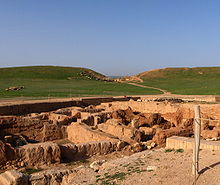
Back ኤብላ Amharic إبلا Arabic ايبلا ARZ Ebla AST Ebla Azerbaijani ابلا AZB Эбла Bashkir Эбла Byelorussian Ебла Bulgarian ইবলা Bengali/Bangla
𒌈𒆷 | |
 Ruins of the outer wall and the "Damascus Gate" | |
| Alternative name | Tell Mardikh تل مرديخ |
|---|---|
| Location | Idlib Governorate, Syria |
| Coordinates | 35°47′53″N 36°47′53″E / 35.798°N 36.798°E |
| Type | settlement |
| History | |
| Founded | c. 3500 BC |
| Abandoned | 7th century AD |
| Periods | Bronze Age |
| Cultures | Kish civilization, Amorite |
| Site notes | |
| Excavation dates | 1964–2011 |
| Archaeologists | Paolo Matthiae |
| Condition | Ruined |
| Ownership | Public |
| Public access | Yes |
Ebla (Sumerian: 𒌈𒆷 eb₂-la,[1] Arabic: إبلا, modern: تل مرديخ, Tell Mardikh) was one of the earliest kingdoms in Syria. Its remains constitute a tell located about 55 km (34 mi) southwest of Aleppo near the village of Mardikh. Ebla was an important center throughout the 3rd millennium BC and in the first half of the 2nd millennium BC. Its discovery proved the Levant was a center of ancient, centralized civilization equal to Egypt and Mesopotamia and ruled out the view that the latter two were the only important centers in the Near East during the Early Bronze Age. The first Eblaite kingdom has been described as the first recorded world power.
Starting as a small settlement in the Early Bronze Age (c. 3500 BC), Ebla developed into a trading empire and later into an expansionist power that imposed its hegemony over much of northern and eastern Syria.[2] Ebla was destroyed during the 23rd century BC. It was then rebuilt and was mentioned in the records of the Third Dynasty of Ur. The second Ebla was a continuation of the first, ruled by a new royal dynasty. It was destroyed at the end of the 3rd millennium BC, which paved the way for the Amorite tribes to settle in the city, forming the third Ebla. The third kingdom also flourished as a trade center; it became a subject and an ally of Yamhad (modern-day Aleppo) until its final destruction by the Hittite king Mursili I in c. 1600 BC.
Ebla maintained its prosperity through a vast trading network. Artifacts from Sumer, Cyprus, Egypt and as far as Afghanistan were recovered from the city's palaces. The kingdom had its own language, Eblaite, and the political organization of Ebla had features different from the Sumerian model. Women enjoyed a special status, and the queen had major influence in the state and religious affairs. The pantheon of gods was mainly north Semitic and included deities exclusive to Ebla. The city was excavated from 1964 and became famous for the Ebla tablets, an archive of about 20,000 cuneiform tablets found there, dated to 2500 BC–2350 BC.[note 1][3][4] Written in both Sumerian and Eblaite and using the cuneiform, the archive has allowed a better understanding of the Sumerian language and provided important information over the political organization and social customs of the mid-3rd millennium BC's Levant.
- ^ "Ebla". Sumerian Dictionary. University of Pennsylvania – via oracc.iaas.upenn.edu.
- ^ Jr, William H. Stiebing (2016). Ancient Near Eastern History and Culture. Routledge. p. 63. ISBN 978-1-315-51116-0.
- ^ Crawford, Sidnie White; Wassen, Cecilia (2015-10-14). The Dead Sea Scrolls at Qumran and the Concept of a Library. BRILL. ISBN 978-90-04-30506-9.
- ^ Chrisomalis, Stephen (2010-01-18). Numerical Notation: A Comparative History. Cambridge University Press. ISBN 978-0-521-87818-0.
Cite error: There are <ref group=note> tags on this page, but the references will not show without a {{reflist|group=note}} template (see the help page).
